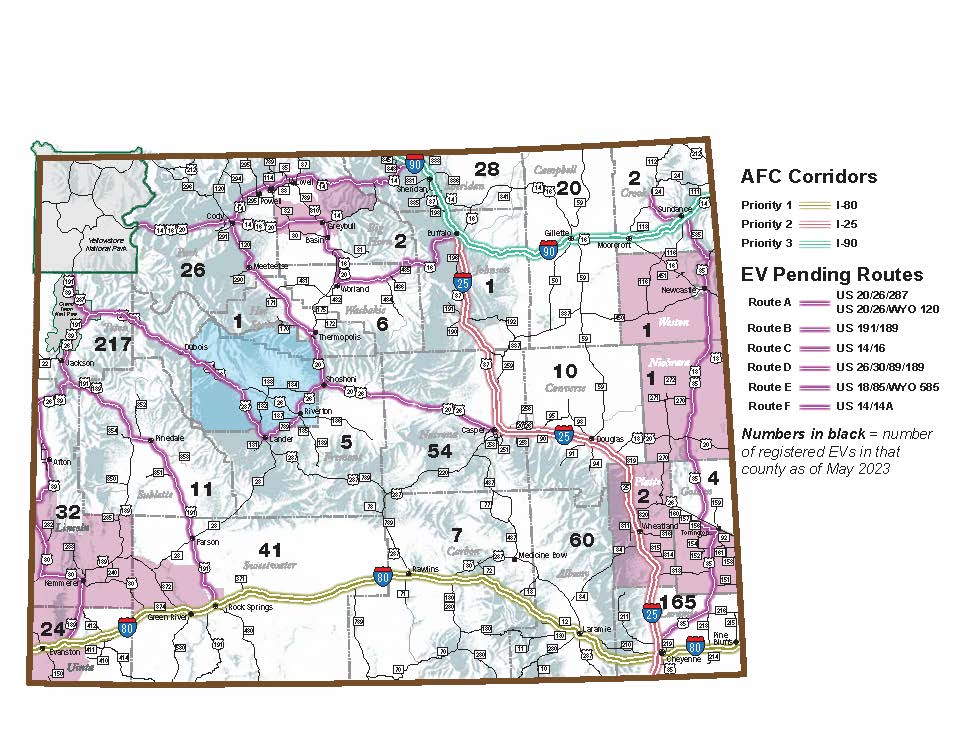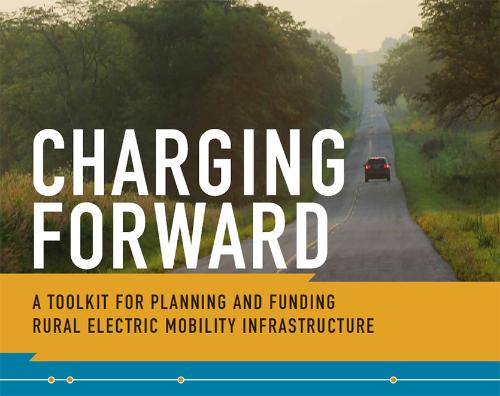- Home
- Administration
- Aeronautics
- Business with WYDOT
- Construction Projects
- Driver License and Records
- Economic Stimulus Projects (ARRA - TIGER)
- Engineering and Technical Programs
- Fuel Tax
- Highway Safety
- Human Resources
- Manuals and Publications
- News and Information
- Permits
- Planning/Projects/Research
- Titles, Plates and Registration
- Travel
- Trucking / Commercial Vehicles
- Vehicle Business Regulation
- Wyoming Highway Patrol
- Search
- Sitemap
EEI develops EV program database
Edison Electric Institute developed an EV Program database to support customers in their transportation electrification efforts. The database includes investor-owned electric company offerings related to electric transportation, including make-ready programs, EV rates, fleet advisory services, charging station incentives, EV incentives, vehicle-grid integration pilots, and more.
Customers can utilize the EEI EV Program database to quickly locate programs that are available or pending in their state, what the programs include, the intended target customers for the program, and links to more information. Information on programs is provided by EEI member companies on a voluntary basis and may not reflect all current EV-related offerings. EEI will update the database quarterly to reflect any new programs that have been approved by state regulators and any changes to existing programs.
Joint Office releases Public Electric Vehicle Charging Infrastructure Playbook
The Joint Office recently released a Public Electric Vehicle Charging Infrastructure Playbook, which "provides interactive resources to help communities plan and build the infrastructure needed to support a zero-emission transportation system."
Communities, planning organizations, local and state governments, tribal nations, and other decision makers can use the Playbook to navigate key considerations for planning and deploying EV infrastructure. The modules include guiding questions, videos, worksheets, and additional resources to drive local progress. Modules can be followed in the order presented or used as stand-alone resources to help with specific priorities.
Access the playbook here: https://driveelectric.gov/ev-infrastructure-playbook
Frequently Asked Questions (FAQ)
How many EVs are registered in Wyoming?

Other FAQs
Q: How does this funding help the state of Wyoming?
A: The Federal funding for EV charging infrastructure will help Wyoming meet current and anticipated demand for electric vehicles, especially by tourists visiting the state. Without it, tourists who drive EVs could be stranded without services or may bypass Wyoming entirely in favor of states with more robust EV infrastructure. Tourism is Wyoming's second-largest industry, and EV infrastructure can help bring tourists to the state.
Q: What happens if the state does not allocate all of the available Federal NEVI formula funding?
A: The Federal Highway Administration will take control of the funds. If they aren’t spent in Wyoming, they will be allocated to other states. Regardless of who is spending it, this funding is required to be spent on EV infrastructure; it cannot be used on roads or bridges.
Q: Will any of the EV infrastructure be state owned, operated or maintained?
A: Currently there are no plans to use state funds in the NEVI formula funding program to own, operate or maintain EV charging stations.
Q: Where will the stations be located?
A: WYDOT's Year 1 and 2 NEVI Plans outline that the first two fiscal years of funding will go toward seven charging stations along the interstates in the following locations: Laramie, Pine Bluffs, Douglas, Buffalo, Sundance, Wheatland and Sheridan. Specific locations within those towns have not been identified but will comply with Federal requirements, local zoning ordinances and other regulations and considerations.
Q: How did you select the corridors and routes?
A: The NEVI program requires that states build out Alternative Fuel Corridors (AFC) first. In Wyoming, those are the three interstates. If there are remaining funds after the corridors have been certified as complete by the US DOT, they may be spent off-corridor. WYDOT preemptively identified routes for off-corridor prioritization, but they are not binding and may be adjusted as the NEVI plan progresses.
Q: I am located on an AFC but your NEVI Plan does not include a station in my city/town. Can I still apply for funding?
A: Towns outside of the seven indicated in Wyoming's NEVI Plan (Laramie, Pine Bluffs, Douglas, Buffalo, Sundance, Wheatland and Sheridan) can apply for funding, but preference will be given to entities within the seven locations. Due to economic feasibility concerns, additional stations in towns that already have NEVI-sized stations will not be considered.
Q: I am located more than 1 mile from an AFC but I am interested in NEVI funding. Can I still apply for funding?
A: Towns located more than 1 mile from an interstate are not yet eligible for NEVI funding and applications will not be considered. Keep an eye out for other grant opportunities on our website.
Q: Did WYDOT ask for an exception to the 50-mile requirements?
A: Yes, Wyoming’s Year 1 NEVI plan requested exceptions to the 50-mile requirement along interstates in a few key areas. Of the eight 50-mile exemptions Wyoming requested, only one was approved. Wyoming expects to ask for exemptions to the 50 mile requirement again in future years.
Q: Are there plans to install charging stations at the rest areas?
A: No, the Federal Government does not allow the commercialization of federally-supported rest areas. Wyoming's rest areas are federally supported.
Q: Will Wyoming’s harsh winters impact EV usage in the state?
A: EVs will be given no special treatment. Much like gas-powered vehicles, drivers will need to plan ahead for proper fuel stops and will need to watch the weather closely as they travel.
Q: Does WYDOT have any data about tourist usage of EVs?
A: No, currently WYDOT does not have exact numbers of out-of-state EV usage. However, we know that about 2 percent of vehicles nationwide are EVs, which we can combine with the annual average daily traffic to get some approximate numbers.
Q: How will EV drivers pay fuel tax?
A: Currently, drivers with EVs registered in Wyoming pay a $200 road maintenance fee as part of their vehicle registration each year. However, there is currently no way for WYDOT to collect fuel tax from out-of-state EV drivers on Wyoming roads. WYDOT is working with the Wyoming Legislature and other state agencies to update statute and policy to address this.
Q: Is WYDOT working with other state/local/national entities on this strategy?
A: Yes! Some of WYDOT’s partners include the state agencies involved the Zero Emission Vehicle Working Group as well as regional partners in the Mountain West. Other partnerships include the National Park Service, local utility companies, local nonprofits like Yellowstone-Teton Clean Cities and regional groups like ChargeWest.
Q: When is the NEVI funding available?
A: More information will be announced, check back for updates.
Q: Do you have any resources for businesses trying to decide if they want to invest in an EV charging station?
A: We recommend contacting your local Wyoming Small Business Development Center Network advisor and check out the Federal Toolkit for Planning and Funding Rural Electric Mobility Infrastructure
Q: I want EV charging stations in my town/at my business, where do I start?
A: More information is expected soon. We recommend keeping an eye on this website for updates or sending us an email.
US DOT compiles "Charging Forward: A Toolkit for Planning and Funding Rural Electric Mobility Infrastructure"

This toolkit is intended for a variety of rural stakeholders, including States, local communities, Tribes, transportation providers, nonprofits, businesses, and individuals.
The toolkit focuses on infrastructure for light-duty electric passenger vehicles (such as sedans, sport utility vehicles, and pickup trucks), but also addresses funding opportunities and planning considerations for other types of electric vehicles, including transit and school buses, medium- and heavy-duty vehicles, and agricultural equipment such as tractors.
To access both the web-based or PDF versions of the kit, click here.
This toolkit covers the stages of EV infrastructure development in the following sections:
- Electric Vehicle Basics
- Benefits and Challenges of Rural Vehicle Electrification
- Partnership Opportunities
- EV Infrastructure Planning for Rural Areas
- EV Infrastructure Funding and Financing for Rural Areas
- Resources for EV Infrastructure Planning
- Environmental Statutes and Executive Orders








